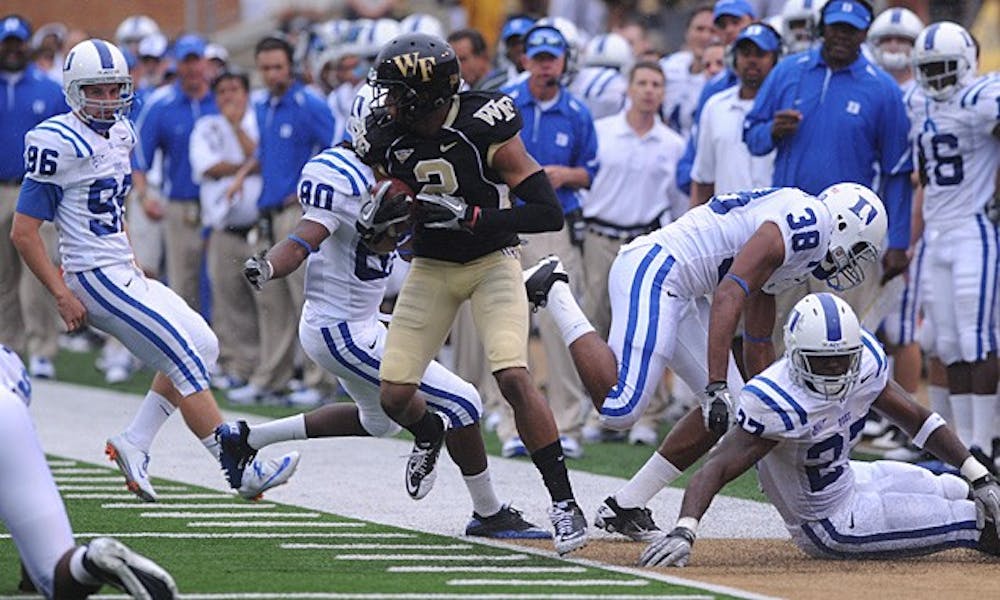Growing up in a family of sports fans, oftentimes our holiday dinners would evolve into a discussion of sports that would resemble ESPN’s Around the Horn. My two brothers, Dad, Grandpa, and I served as the cast, and even Mom and Grandma would chime in with analysis that would make most women raise their eyebrows.
One of my grandfather’s favorite college sports theories was that there should exist an All-Academic sports conference. The participating schools would include Duke, Northwestern, Stanford, Vanderbilt, Rice, Army, Navy and Air Force. Always an old-school advocate of the student-athlete, he looked at this setup as a way to even the playing field for the smaller private schools, specifically in football.
This past weekend’s demolition at the hands of Alabama in front of a split crowd at Duke’s home stadium serves as a perfect representation of the spoils that the big state schools enjoy in football. College football has become such a big business that the pure volume of alumni, boosters and other supporters creates a cash cow that fuels recruiting and allows today’s national powerhouses to function almost like professional teams.
For this reason, it is my personal opinion that a private institution other than USC or Miami will never win another NCAA national championship.
Looking at the history books, one can’t help but notice that since 1960, only four different private schools—Notre Dame, USC, Miami and BYU—have won the consensus national title outright.
All of these schools, though, had unusual circumstances surrounding their successes that aren’t afforded to the traditional private school is in today’s college football landscape.
BYU won by vote 26 years ago while going undefeated, an accolatde that has not been reciprocated to modern, unbeaten non-BCS teams. Miami began its reign with an NFL stadium to play in and the “State of Miami” talent-pool to recruit from.
Notre Dame, with its 80,000-seat stadium, TV contract and rich football tradition isn’t remotely close to being a traditional private school from an athletic standpoint. And USC, with its sizable student body, support from a large metropolitan area and lack of a pro football team in Los Angeles sticks out like a sore thumb when grouped with these other high-achieving academic institutions.
Still, that doesn’t mean that one of these more representative private schools can’t enjoy a very successful football season. In just the past 10 years, Stanford, Northwestern and Wake Forest have each overcome their inherent disadvantages to turn heads with very impressive runs. If I were on the Duke coaching staff, I would be dissecting the runs that these teams had in an attempt to replicate them.
Stanford posted a 9-3 record in 2001 before head coach Tyrone Willingham moved onto what he thought were greener pastures and, more recently, went 8-5 last season and nearly upset Oklahoma in the Sun Bowl by relying on the legs of Heisman contender Toby Gerhart.
Northwestern, a program that not only consistently boasts one of Division I-A’s highest graduation rates but also has five bowl game appearances since 2000, has found a way to compensate for its lack of raw athleticism by relying on a unique form of the spread offense.
And Wake Forest, despite being the smallest school in a BCS conference, has played in four bowl games, including the 2006 Orange Bowl, in this decade. Head coach Jim Grobe has done a tremendous job in recruiting players that fit into his complicated offense that combines the spread passing attack with the triple option.
For smaller private schools operating on lesser budgets, down seasons are almost a guarantee as standout coaches are likely to leave for bigger paychecks and their talent that may have slipped through the cracks will eventually graduate.
But, based on these schools’ successes, it is critical to have a head coach with a system that allows for smaller players to be competitive. Also, the importance of recruiting talented players at the playmaking positions that the bigger schools overlook cannot be overstated.
In terms of the picture that these case studies paint for Duke’s prospects, I think it is very promising. First, head coach David Cutcliffe has made it clear that he is in it for the long haul and hopes to make Duke his legacy project. So, he just needs to continue to bring in talented playmakers to surround his hand-picked quarterback and increase the speed and physicality of the defense.
The reality is that he has no other choice. My grandfather’s dream of an All-Academic conference is nothing more than that. Like Northwestern, Wake Forest and Stanford, Cutcliffe will need to find creative ways to bring down the titans of his conference.
Get The Chronicle straight to your inbox
Signup for our weekly newsletter. Cancel at any time.

